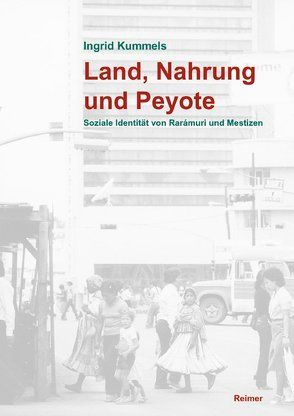
This book provides the first comprehensive grammatical description of Choguita Rarámuri, a Uto-Aztecan language spoken in the Sierra Tarahumara, a mountainous range in the northern Mexican state of Chihuahua belonging to the Sierra Madre Occidental. A documentary corpus developed between 2003 and 2018 with Choguita Rarámuri language experts informs the analysis and is the source of the examples presented in this grammar. The documentary corpus, which consists of over 200 hours of recordings of elicited data, narratives, conversations, interviews, and other speech genres, is available in two archival collections housed at the Endangered Languages Archive and at UC Berkeley’s Survey of California and Other Indian Languages.
Choguita Rarámuri is a highly synthetic, agglutinating language with a complex morphological system. It displays many of the recurrent structural features documented across Uto-Aztecan, including a predominance of suffixation, head-marking, and patterns of noun-incorporation and compounding (Sapir 1921; Whorf 1935; Haugen 2008b). Other features of typological and theoretical interest include a complex word prosodic system, a wide range of morphologically conditioned phonological processes, and patterns of variable affix order and multiple exponence. Choguita Rarámuri is also of great comparative/historical importance: while several analytical works of Uto-Aztecan languages of Northern Mexico have been produced in the last years (Guerrero Valenzuela 2006, García Salido 2014, Reyes Taboada 2014, Morales Moreno 2016, Villalpando Quiñonez 2019, inter alia), many varieties still lack comprehensive linguistic description and documentation.
Aktualisiert: 2023-06-16
> findR *

This book provides the first comprehensive grammatical description of Choguita Rarámuri, a Uto-Aztecan language spoken in the Sierra Tarahumara, a mountainous range in the northern Mexican state of Chihuahua belonging to the Sierra Madre Occidental. A documentary corpus developed between 2003 and 2018 with Choguita Rarámuri language experts informs the analysis and is the source of the examples presented in this grammar. The documentary corpus, which consists of over 200 hours of recordings of elicited data, narratives, conversations, interviews, and other speech genres, is available in two archival collections housed at the Endangered Languages Archive and at UC Berkeley’s Survey of California and Other Indian Languages.
Choguita Rarámuri is a highly synthetic, agglutinating language with a complex morphological system. It displays many of the recurrent structural features documented across Uto-Aztecan, including a predominance of suffixation, head-marking, and patterns of noun-incorporation and compounding (Sapir 1921; Whorf 1935; Haugen 2008b). Other features of typological and theoretical interest include a complex word prosodic system, a wide range of morphologically conditioned phonological processes, and patterns of variable affix order and multiple exponence. Choguita Rarámuri is also of great comparative/historical importance: while several analytical works of Uto-Aztecan languages of Northern Mexico have been produced in the last years (Guerrero Valenzuela 2006, García Salido 2014, Reyes Taboada 2014, Morales Moreno 2016, Villalpando Quiñonez 2019, inter alia), many varieties still lack comprehensive linguistic description and documentation.
Aktualisiert: 2023-06-16
> findR *

This book provides the first comprehensive grammatical description of Choguita Rarámuri, a Uto-Aztecan language spoken in the Sierra Tarahumara, a mountainous range in the northern Mexican state of Chihuahua belonging to the Sierra Madre Occidental. A documentary corpus developed between 2003 and 2018 with Choguita Rarámuri language experts informs the analysis and is the source of the examples presented in this grammar. The documentary corpus, which consists of over 200 hours of recordings of elicited data, narratives, conversations, interviews, and other speech genres, is available in two archival collections housed at the Endangered Languages Archive and at UC Berkeley’s Survey of California and Other Indian Languages.
Choguita Rarámuri is a highly synthetic, agglutinating language with a complex morphological system. It displays many of the recurrent structural features documented across Uto-Aztecan, including a predominance of suffixation, head-marking, and patterns of noun-incorporation and compounding (Sapir 1921; Whorf 1935; Haugen 2008b). Other features of typological and theoretical interest include a complex word prosodic system, a wide range of morphologically conditioned phonological processes, and patterns of variable affix order and multiple exponence. Choguita Rarámuri is also of great comparative/historical importance: while several analytical works of Uto-Aztecan languages of Northern Mexico have been produced in the last years (Guerrero Valenzuela 2006, García Salido 2014, Reyes Taboada 2014, Morales Moreno 2016, Villalpando Quiñonez 2019, inter alia), many varieties still lack comprehensive linguistic description and documentation.
Aktualisiert: 2023-06-16
> findR *

This book provides the first comprehensive grammatical description of Choguita Rarámuri, a Uto-Aztecan language spoken in the Sierra Tarahumara, a mountainous range in the northern Mexican state of Chihuahua belonging to the Sierra Madre Occidental. A documentary corpus developed between 2003 and 2018 with Choguita Rarámuri language experts informs the analysis and is the source of the examples presented in this grammar. The documentary corpus, which consists of over 200 hours of recordings of elicited data, narratives, conversations, interviews, and other speech genres, is available in two archival collections housed at the Endangered Languages Archive and at UC Berkeley’s Survey of California and Other Indian Languages.
Choguita Rarámuri is a highly synthetic, agglutinating language with a complex morphological system. It displays many of the recurrent structural features documented across Uto-Aztecan, including a predominance of suffixation, head-marking, and patterns of noun-incorporation and compounding (Sapir 1921; Whorf 1935; Haugen 2008b). Other features of typological and theoretical interest include a complex word prosodic system, a wide range of morphologically conditioned phonological processes, and patterns of variable affix order and multiple exponence. Choguita Rarámuri is also of great comparative/historical importance: while several analytical works of Uto-Aztecan languages of Northern Mexico have been produced in the last years (Guerrero Valenzuela 2006, García Salido 2014, Reyes Taboada 2014, Morales Moreno 2016, Villalpando Quiñonez 2019, inter alia), many varieties still lack comprehensive linguistic description and documentation.
Aktualisiert: 2023-05-11
> findR *

This book provides the first comprehensive grammatical description of Choguita Rarámuri, a Uto-Aztecan language spoken in the Sierra Tarahumara, a mountainous range in the northern Mexican state of Chihuahua belonging to the Sierra Madre Occidental. A documentary corpus developed between 2003 and 2018 with Choguita Rarámuri language experts informs the analysis and is the source of the examples presented in this grammar. The documentary corpus, which consists of over 200 hours of recordings of elicited data, narratives, conversations, interviews, and other speech genres, is available in two archival collections housed at the Endangered Languages Archive and at UC Berkeley’s Survey of California and Other Indian Languages.
Choguita Rarámuri is a highly synthetic, agglutinating language with a complex morphological system. It displays many of the recurrent structural features documented across Uto-Aztecan, including a predominance of suffixation, head-marking, and patterns of noun-incorporation and compounding (Sapir 1921; Whorf 1935; Haugen 2008b). Other features of typological and theoretical interest include a complex word prosodic system, a wide range of morphologically conditioned phonological processes, and patterns of variable affix order and multiple exponence. Choguita Rarámuri is also of great comparative/historical importance: while several analytical works of Uto-Aztecan languages of Northern Mexico have been produced in the last years (Guerrero Valenzuela 2006, García Salido 2014, Reyes Taboada 2014, Morales Moreno 2016, Villalpando Quiñonez 2019, inter alia), many varieties still lack comprehensive linguistic description and documentation.
Aktualisiert: 2023-01-04
> findR *
Im Grenzstaat Chihuahua entstand in den 1980er und 1990er Jahren ein neuer Regionalismus. In Opposition zur zentralmexikanischen Politik definierten sich dort Mestizen (norteños) als direkte Nachfahren der Spanier. Sie grenzten sich zu diesem Zweck von den ebenfalls dort lebenden Rarámuri (Tarahumara) ab und diskriminierten sie als 'primitiv', verherrlichten sie aber auch als 'ursprünglich '. Die Rarámuri kämpften ihrerseits um ein größeres politisches Gewicht. Ethnopolitische Bewegungen um Land, Streit um Deutungsmacht im Rahmen des Kults um den halluzinogenen Peyote und die Migration von Frauen und Kindern in die Städte, widersprachen dem mestizischen Indianerbild. Die Langzeitstudie von Ingrid Kummels bietet einen detaillierten Einblick in die dynamischen und vielgestaltigen Prozesse der sozialen Kategorisierung und der Hybridisierung von Kultur in den US-mexikanischen borderlands.
Aktualisiert: 2019-10-11
> findR *
MEHR ANZEIGEN
Bücher zum Thema Rarámuri
Sie suchen ein Buch über Rarámuri? Bei Buch findr finden Sie eine große Auswahl Bücher zum
Thema Rarámuri. Entdecken Sie neue Bücher oder Klassiker für Sie selbst oder zum Verschenken. Buch findr
hat zahlreiche Bücher zum Thema Rarámuri im Sortiment. Nehmen Sie sich Zeit zum Stöbern und finden Sie das
passende Buch für Ihr Lesevergnügen. Stöbern Sie durch unser Angebot und finden Sie aus unserer großen Auswahl das
Buch, das Ihnen zusagt. Bei Buch findr finden Sie Romane, Ratgeber, wissenschaftliche und populärwissenschaftliche
Bücher uvm. Bestellen Sie Ihr Buch zum Thema Rarámuri einfach online und lassen Sie es sich bequem nach
Hause schicken. Wir wünschen Ihnen schöne und entspannte Lesemomente mit Ihrem Buch.
Rarámuri - Große Auswahl Bücher bei Buch findr
Bei uns finden Sie Bücher beliebter Autoren, Neuerscheinungen, Bestseller genauso wie alte Schätze. Bücher zum
Thema Rarámuri, die Ihre Fantasie anregen und Bücher, die Sie weiterbilden und Ihnen wissenschaftliche
Fakten vermitteln. Ganz nach Ihrem Geschmack ist das passende Buch für Sie dabei. Finden Sie eine große Auswahl
Bücher verschiedenster Genres, Verlage, Autoren bei Buchfindr:
Sie haben viele Möglichkeiten bei Buch findr die passenden Bücher für Ihr Lesevergnügen zu entdecken. Nutzen Sie
unsere Suchfunktionen, um zu stöbern und für Sie interessante Bücher in den unterschiedlichen Genres und Kategorien
zu finden. Unter Rarámuri und weitere Themen und Kategorien finden Sie schnell und einfach eine Auflistung
thematisch passender Bücher. Probieren Sie es aus, legen Sie jetzt los! Ihrem Lesevergnügen steht nichts im Wege.
Nutzen Sie die Vorteile Ihre Bücher online zu kaufen und bekommen Sie die bestellten Bücher schnell und bequem
zugestellt. Nehmen Sie sich die Zeit, online die Bücher Ihrer Wahl anzulesen, Buchempfehlungen und Rezensionen zu
studieren, Informationen zu Autoren zu lesen. Viel Spaß beim Lesen wünscht Ihnen das Team von Buchfindr.





